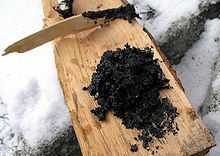Birch-tar


Birch tar or birch pitch is a substance (liquid when heated) derived from the dry distillation of the bark of the birch tree.
Compounds
It is compounded of phenols such as guaiacol, cresol, xylenol and creosol.
Uses
Birch tar was used widely as an adhesive as early as the late Paleolithic or early Mesolithic era. It has also been used as a disinfectant, in leather dressing, and in medicine.[citation needed]
Ends of fletching of arrows were fastened with birch-tar and birch-tar-and-rawhide lashings were used to fix the blade of axes in the Mesolithic period.
Russia leather is a water-resistant leather, oiled with birch oil after tanning. This leather was a major export good from 17th and 18th century Russia, as the availability of birch oil limited its geographical production.[1] The oil impregnation also deterred insect attack and gave a distinctive and pleasant aroma that was seen as a mark of quality in leather.
Birch tar oil is an effective repellent of gastropods.[2] The repellent effect lasts about two weeks.[2] The repellent effect of birch tar oil mixed with petroleum jelly applied to a fence lasts up to several months.[2]
Birch tar oil is also used in perfumery as a base note to impart leather, tar, smoky, and wintergreen notes.
References
- ↑ "Production of Russia Leather". The Honourable Cordwainers' Company. 1807.
- ↑ 2.0 2.1 2.2 Lindqvist I., Lindqvist B., Tiilikkala K., Hagner M., Penttinen O.-P., Pasanen T. & Setälä H. (2010). "Birch tar oil is an effective mollusc repellent: field and laboratory experiments using Arianta arbustorum (Gastropoda: Helicidae) and Arion lusitanicus (Gastropoda: Arionidae)". Agricultural and Food Science 19(1): 1-12. doi:10.2137/145960610791015050.
External links
| |||||||||||||||||||||||||||||||||||
